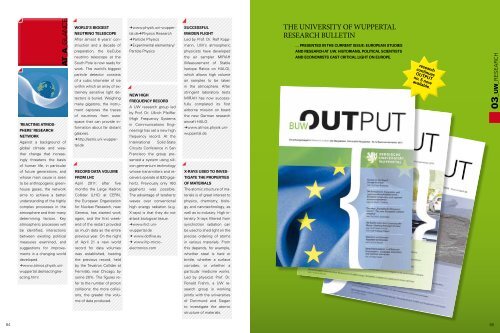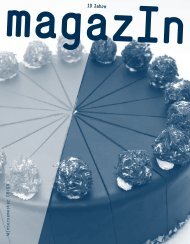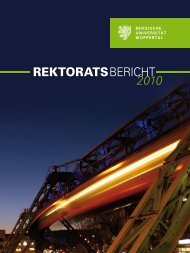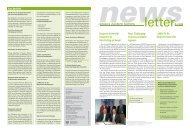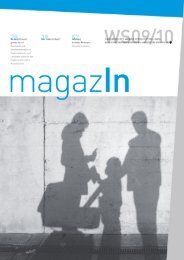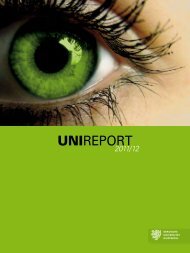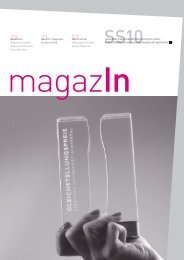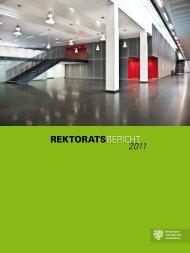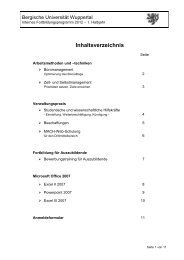international - Bergische Universität Wuppertal
international - Bergische Universität Wuppertal
international - Bergische Universität Wuppertal
Create successful ePaper yourself
Turn your PDF publications into a flip-book with our unique Google optimized e-Paper software.
64<br />
At_A_GLANCE<br />
‘reACtinG AtMos-<br />
PHere’ reseArCH<br />
netWorK<br />
Against a background of<br />
global climate and weather<br />
change that increasingly<br />
threatens the basis<br />
of human life, in particular<br />
of future generations, and<br />
whose main cause is seen<br />
to be anthropogenic greenhouse<br />
gases, the network<br />
aims to achieve a better<br />
understanding of the highly<br />
complex processes in the<br />
atmosphere and their many<br />
determining factors. Key<br />
atmospheric processes will<br />
be identified, interactions<br />
between existing political<br />
measures examined, and<br />
suggestions for improvements<br />
in a changing world<br />
developed.<br />
kwww.atmos.physik.uniwuppertal.de/reacting/reacting.html<br />
WorLd’s biGGest<br />
neutrino teLesCoPe<br />
After almost 6 years’ con-<br />
struction and a decade of<br />
preparation, the IceCube<br />
neutrino telescope at the<br />
South Pole is now ready for<br />
work. The world’s biggest<br />
particle detector consists<br />
of a cubic kilometer of ice<br />
within which an array of extremely<br />
sensitive light detectors<br />
is buried. Weighing<br />
many gigatons, the instrument<br />
captures the traces<br />
of neutrinos from outer<br />
space that can provide information<br />
about far distant<br />
galaxies.<br />
khttp://astro.uni-wuppertal.de<br />
reCord dAtA VoLuMe<br />
FroM LHC<br />
April 2011: after five<br />
months the Large Hadron<br />
Collider (LHC) at CERN,<br />
the European organization<br />
for Nuclear Research, near<br />
Geneva, has started work<br />
again, and the first weekend<br />
of the restart provided<br />
as much data as the entire<br />
previous year. on the night<br />
of April 21 a new world<br />
record for data volumes<br />
was established, beating<br />
the previous record, held<br />
by the Tevatron Collider at<br />
Fermilab, near Chicago, by<br />
some 20%. The figures refer<br />
to the number of proton<br />
collisions: the more collisions,<br />
the greater the volume<br />
of data produced.<br />
kwww.physik.uni-wuppertal.dekPhysics<br />
Research<br />
kParticle Physics<br />
kExperimental elementary/<br />
Particle Physics<br />
neW HiGH<br />
FreQuenCy reCord<br />
A UW research group led<br />
by Prof. Dr. Ullrich Pfeiffer<br />
(High Frequency Systems<br />
in Communications Engineering)<br />
has set a new high<br />
frequency record. At the<br />
International Solid-State<br />
Circuits Conference in San<br />
Francisco the group presented<br />
a system using silicon<br />
germanium technology<br />
whose transmitters and receivers<br />
operate at 820 gigahertz.<br />
Previously only 160<br />
gigahertz was possible.<br />
The advantage of terahertz<br />
waves over conventional<br />
high energy radiation (e.g.<br />
X-rays) is that they do not<br />
attack biological tissue.<br />
kwww.ihct.uniwuppertal.de<br />
k www.dotfive.eu<br />
k www.ihp-microelectronics.com<br />
suCCessFuL<br />
MAiden FLiGHt<br />
Led by Prof. Dr. Ralf Koppmann,<br />
UW’s atmospheric<br />
physicists have developed<br />
the air sampler MIRAH<br />
(Measurement of Stable<br />
Isotope Ratios on HALo),<br />
which allows high volume<br />
air samples to be taken<br />
in the atmosphere. After<br />
stringent laboratory tests<br />
MIRAH has now successfully<br />
completed its first<br />
airborne mission on board<br />
the new German research<br />
aircraft HALo.<br />
kwww.atmos.physik.uniwuppertal.de<br />
x-rAys used to inVestiGAte<br />
tHe ProPerties<br />
oF MAteriALs<br />
The atomic structure of materials<br />
is of great interest to<br />
physics, chemistry, biology<br />
and nanotechnology, as<br />
well as to industry. High intensity<br />
X-rays filtered from<br />
synchrotron radiation can<br />
be used to shed light on the<br />
precise ordering of atoms<br />
in various materials. From<br />
this depends, for example,<br />
whether steel is hard or<br />
brittle, whether a surface<br />
corrodes, or whether a<br />
particular medicine works.<br />
Led by physicist Prof. Dr.<br />
Ronald Frahm, a UW research<br />
group is working<br />
jointly with the universities<br />
of Dortmund and Siegen<br />
to investigate the atomic<br />
structure of materials.<br />
the University of WUppertal<br />
researCh bUlletin<br />
… Presented in tHe Current issue: euroPeAn studies<br />
And reseArCH At uW. HistoriAns, PoLitiCAL sCientists<br />
And eConoMists CAst CritiCAL LiGHt on euroPe.<br />
research<br />
continues<br />
outPut<br />
no. 5 now<br />
available.<br />
03_UW_RESEARCH<br />
65


